Annotated Bibliography on Conferencing in the Writing Classroom
VerifiedAdded on 2020/03/04
|6
|1546
|53
Annotated Bibliography
AI Summary
This annotated bibliography examines the significance of conferencing in the writing classroom. It draws upon several key sources, including works by Carl Anderson, Fountas & Pinnell, and Joanne Hindley. The sources emphasize the benefits of writing conferences for student writers, highlighting how they facilitate reflection, feedback, and improvement. The bibliography explores teacher and peer roles in providing constructive criticism and motivation. It also discusses effective strategies for managing writing workshops and assessing student work to tailor instruction. The annotated entries provide insights into techniques, strategies, and the overall impact of writing conferences on student writing development and classroom management. The research stresses the importance of creating a supportive environment where students can learn and grow as writers.
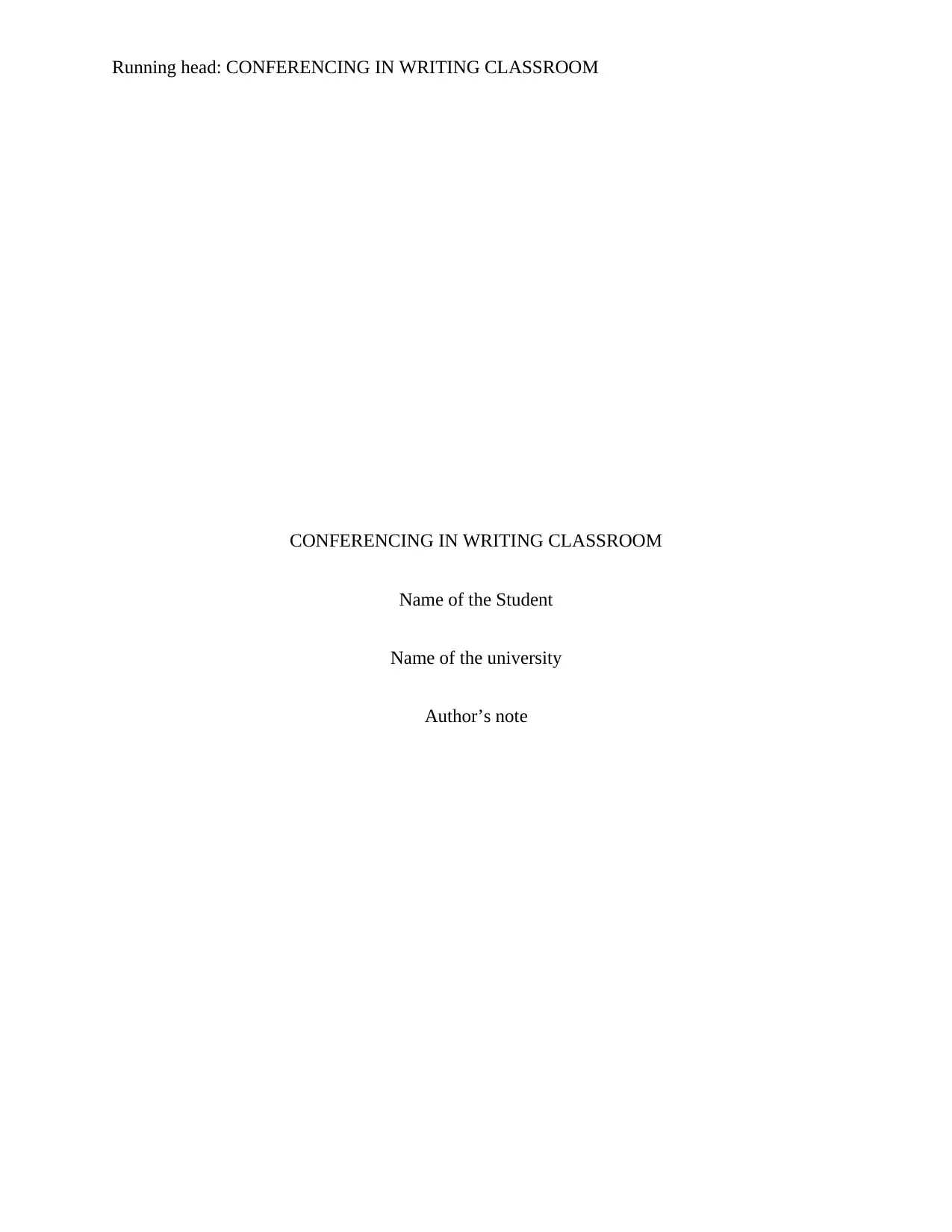
Running head: CONFERENCING IN WRITING CLASSROOM
CONFERENCING IN WRITING CLASSROOM
Name of the Student
Name of the university
Author’s note
CONFERENCING IN WRITING CLASSROOM
Name of the Student
Name of the university
Author’s note
Paraphrase This Document
Need a fresh take? Get an instant paraphrase of this document with our AI Paraphraser
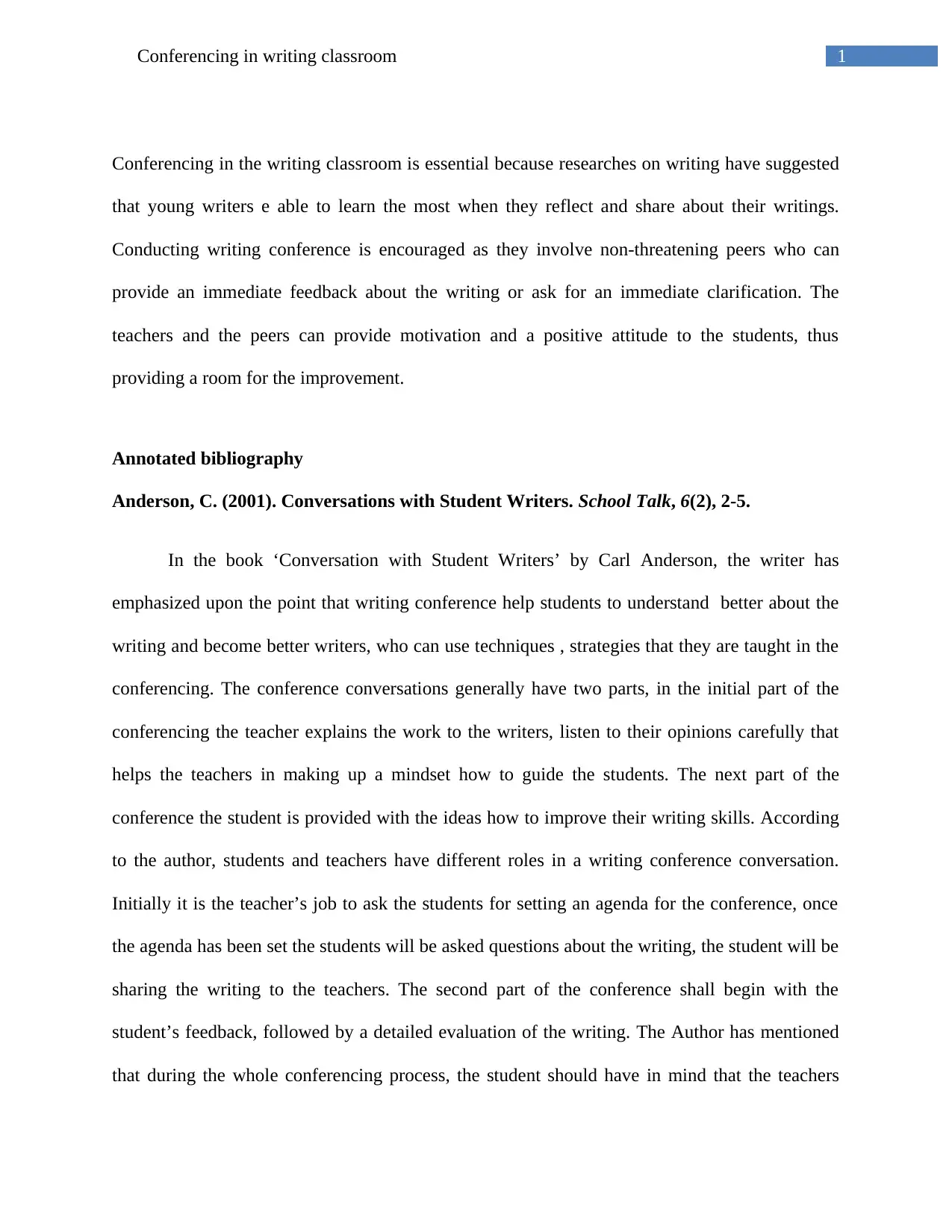
1Conferencing in writing classroom
Conferencing in the writing classroom is essential because researches on writing have suggested
that young writers e able to learn the most when they reflect and share about their writings.
Conducting writing conference is encouraged as they involve non-threatening peers who can
provide an immediate feedback about the writing or ask for an immediate clarification. The
teachers and the peers can provide motivation and a positive attitude to the students, thus
providing a room for the improvement.
Annotated bibliography
Anderson, C. (2001). Conversations with Student Writers. School Talk, 6(2), 2-5.
In the book ‘Conversation with Student Writers’ by Carl Anderson, the writer has
emphasized upon the point that writing conference help students to understand better about the
writing and become better writers, who can use techniques , strategies that they are taught in the
conferencing. The conference conversations generally have two parts, in the initial part of the
conferencing the teacher explains the work to the writers, listen to their opinions carefully that
helps the teachers in making up a mindset how to guide the students. The next part of the
conference the student is provided with the ideas how to improve their writing skills. According
to the author, students and teachers have different roles in a writing conference conversation.
Initially it is the teacher’s job to ask the students for setting an agenda for the conference, once
the agenda has been set the students will be asked questions about the writing, the student will be
sharing the writing to the teachers. The second part of the conference shall begin with the
student’s feedback, followed by a detailed evaluation of the writing. The Author has mentioned
that during the whole conferencing process, the student should have in mind that the teachers
Conferencing in the writing classroom is essential because researches on writing have suggested
that young writers e able to learn the most when they reflect and share about their writings.
Conducting writing conference is encouraged as they involve non-threatening peers who can
provide an immediate feedback about the writing or ask for an immediate clarification. The
teachers and the peers can provide motivation and a positive attitude to the students, thus
providing a room for the improvement.
Annotated bibliography
Anderson, C. (2001). Conversations with Student Writers. School Talk, 6(2), 2-5.
In the book ‘Conversation with Student Writers’ by Carl Anderson, the writer has
emphasized upon the point that writing conference help students to understand better about the
writing and become better writers, who can use techniques , strategies that they are taught in the
conferencing. The conference conversations generally have two parts, in the initial part of the
conferencing the teacher explains the work to the writers, listen to their opinions carefully that
helps the teachers in making up a mindset how to guide the students. The next part of the
conference the student is provided with the ideas how to improve their writing skills. According
to the author, students and teachers have different roles in a writing conference conversation.
Initially it is the teacher’s job to ask the students for setting an agenda for the conference, once
the agenda has been set the students will be asked questions about the writing, the student will be
sharing the writing to the teachers. The second part of the conference shall begin with the
student’s feedback, followed by a detailed evaluation of the writing. The Author has mentioned
that during the whole conferencing process, the student should have in mind that the teachers
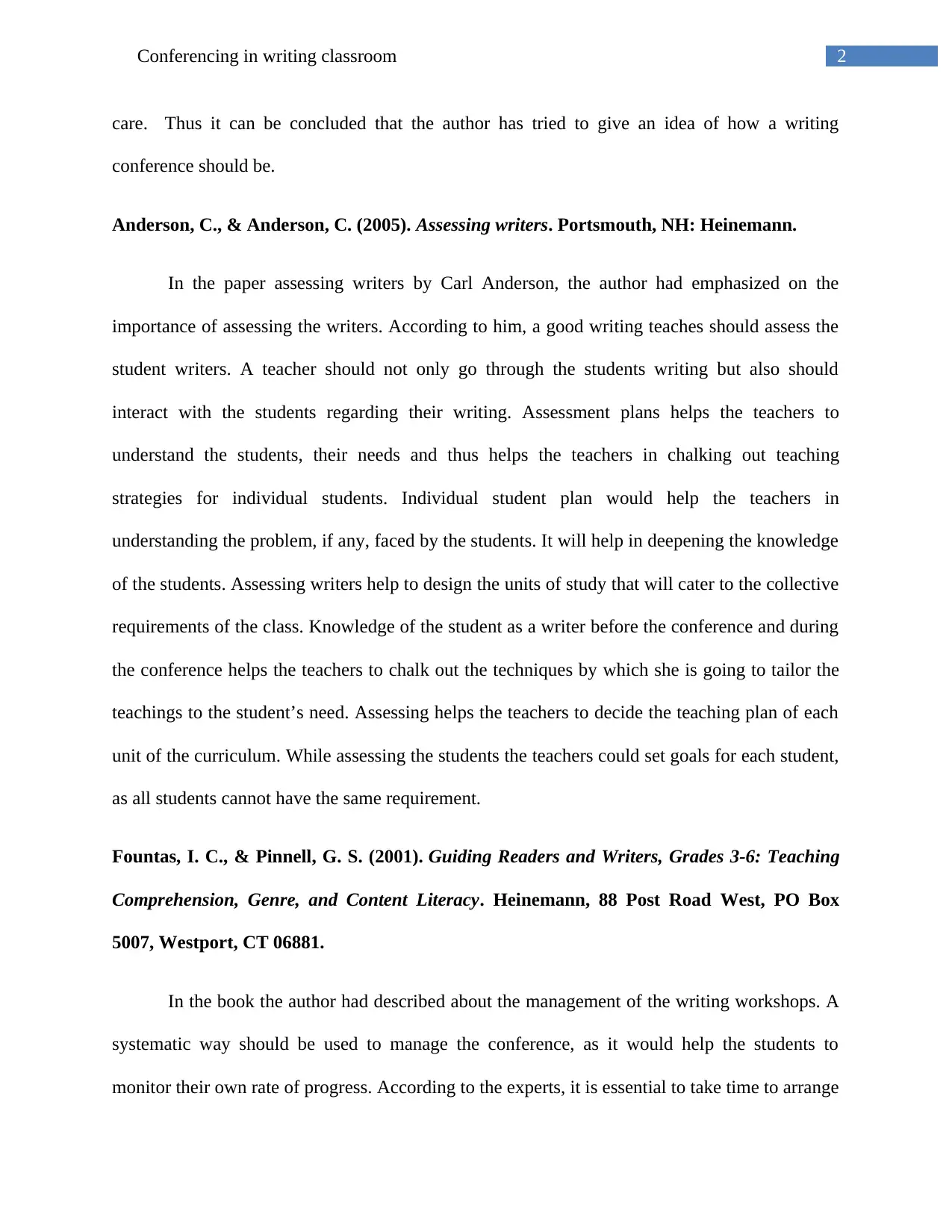
2Conferencing in writing classroom
care. Thus it can be concluded that the author has tried to give an idea of how a writing
conference should be.
Anderson, C., & Anderson, C. (2005). Assessing writers. Portsmouth, NH: Heinemann.
In the paper assessing writers by Carl Anderson, the author had emphasized on the
importance of assessing the writers. According to him, a good writing teaches should assess the
student writers. A teacher should not only go through the students writing but also should
interact with the students regarding their writing. Assessment plans helps the teachers to
understand the students, their needs and thus helps the teachers in chalking out teaching
strategies for individual students. Individual student plan would help the teachers in
understanding the problem, if any, faced by the students. It will help in deepening the knowledge
of the students. Assessing writers help to design the units of study that will cater to the collective
requirements of the class. Knowledge of the student as a writer before the conference and during
the conference helps the teachers to chalk out the techniques by which she is going to tailor the
teachings to the student’s need. Assessing helps the teachers to decide the teaching plan of each
unit of the curriculum. While assessing the students the teachers could set goals for each student,
as all students cannot have the same requirement.
Fountas, I. C., & Pinnell, G. S. (2001). Guiding Readers and Writers, Grades 3-6: Teaching
Comprehension, Genre, and Content Literacy. Heinemann, 88 Post Road West, PO Box
5007, Westport, CT 06881.
In the book the author had described about the management of the writing workshops. A
systematic way should be used to manage the conference, as it would help the students to
monitor their own rate of progress. According to the experts, it is essential to take time to arrange
care. Thus it can be concluded that the author has tried to give an idea of how a writing
conference should be.
Anderson, C., & Anderson, C. (2005). Assessing writers. Portsmouth, NH: Heinemann.
In the paper assessing writers by Carl Anderson, the author had emphasized on the
importance of assessing the writers. According to him, a good writing teaches should assess the
student writers. A teacher should not only go through the students writing but also should
interact with the students regarding their writing. Assessment plans helps the teachers to
understand the students, their needs and thus helps the teachers in chalking out teaching
strategies for individual students. Individual student plan would help the teachers in
understanding the problem, if any, faced by the students. It will help in deepening the knowledge
of the students. Assessing writers help to design the units of study that will cater to the collective
requirements of the class. Knowledge of the student as a writer before the conference and during
the conference helps the teachers to chalk out the techniques by which she is going to tailor the
teachings to the student’s need. Assessing helps the teachers to decide the teaching plan of each
unit of the curriculum. While assessing the students the teachers could set goals for each student,
as all students cannot have the same requirement.
Fountas, I. C., & Pinnell, G. S. (2001). Guiding Readers and Writers, Grades 3-6: Teaching
Comprehension, Genre, and Content Literacy. Heinemann, 88 Post Road West, PO Box
5007, Westport, CT 06881.
In the book the author had described about the management of the writing workshops. A
systematic way should be used to manage the conference, as it would help the students to
monitor their own rate of progress. According to the experts, it is essential to take time to arrange
⊘ This is a preview!⊘
Do you want full access?
Subscribe today to unlock all pages.

Trusted by 1+ million students worldwide
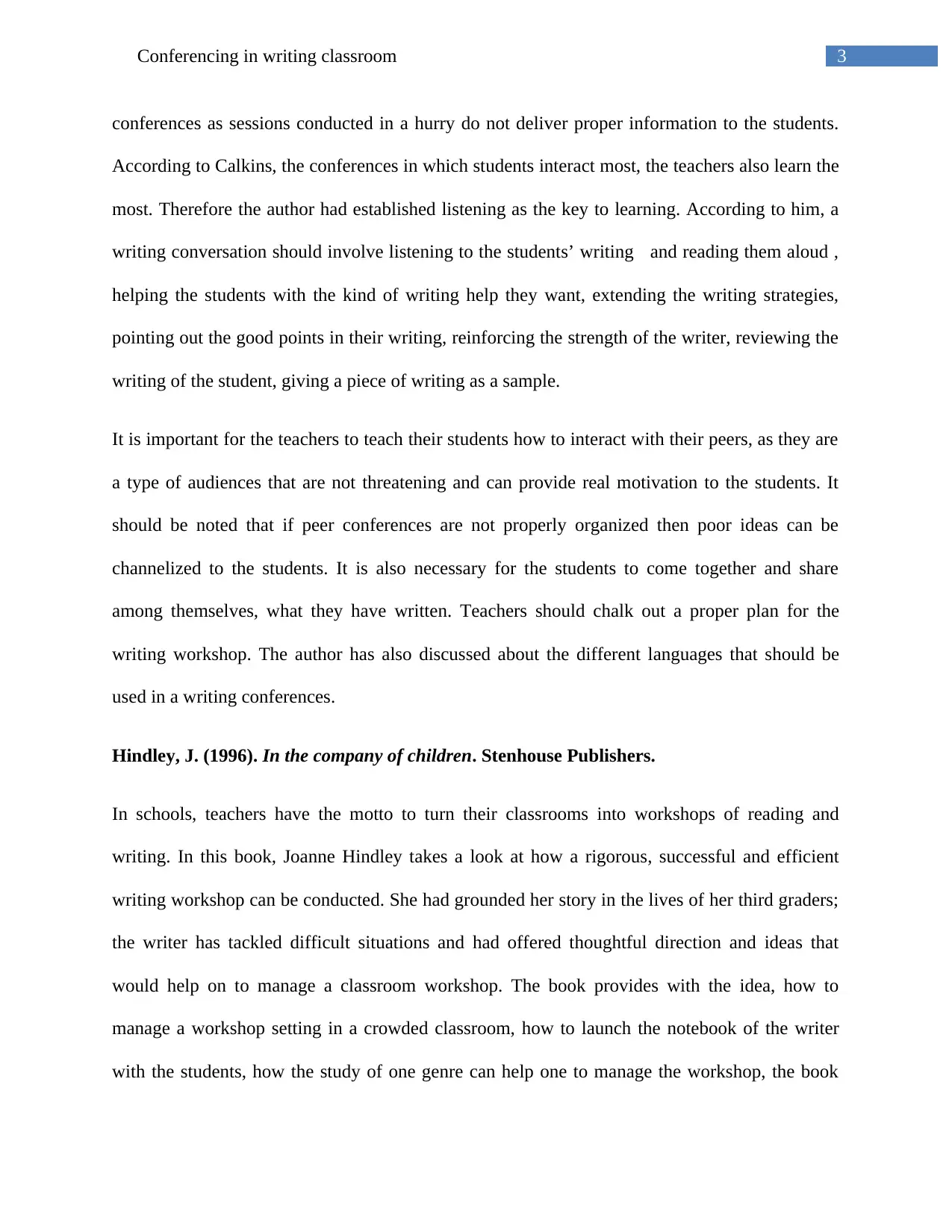
3Conferencing in writing classroom
conferences as sessions conducted in a hurry do not deliver proper information to the students.
According to Calkins, the conferences in which students interact most, the teachers also learn the
most. Therefore the author had established listening as the key to learning. According to him, a
writing conversation should involve listening to the students’ writing and reading them aloud ,
helping the students with the kind of writing help they want, extending the writing strategies,
pointing out the good points in their writing, reinforcing the strength of the writer, reviewing the
writing of the student, giving a piece of writing as a sample.
It is important for the teachers to teach their students how to interact with their peers, as they are
a type of audiences that are not threatening and can provide real motivation to the students. It
should be noted that if peer conferences are not properly organized then poor ideas can be
channelized to the students. It is also necessary for the students to come together and share
among themselves, what they have written. Teachers should chalk out a proper plan for the
writing workshop. The author has also discussed about the different languages that should be
used in a writing conferences.
Hindley, J. (1996). In the company of children. Stenhouse Publishers.
In schools, teachers have the motto to turn their classrooms into workshops of reading and
writing. In this book, Joanne Hindley takes a look at how a rigorous, successful and efficient
writing workshop can be conducted. She had grounded her story in the lives of her third graders;
the writer has tackled difficult situations and had offered thoughtful direction and ideas that
would help on to manage a classroom workshop. The book provides with the idea, how to
manage a workshop setting in a crowded classroom, how to launch the notebook of the writer
with the students, how the study of one genre can help one to manage the workshop, the book
conferences as sessions conducted in a hurry do not deliver proper information to the students.
According to Calkins, the conferences in which students interact most, the teachers also learn the
most. Therefore the author had established listening as the key to learning. According to him, a
writing conversation should involve listening to the students’ writing and reading them aloud ,
helping the students with the kind of writing help they want, extending the writing strategies,
pointing out the good points in their writing, reinforcing the strength of the writer, reviewing the
writing of the student, giving a piece of writing as a sample.
It is important for the teachers to teach their students how to interact with their peers, as they are
a type of audiences that are not threatening and can provide real motivation to the students. It
should be noted that if peer conferences are not properly organized then poor ideas can be
channelized to the students. It is also necessary for the students to come together and share
among themselves, what they have written. Teachers should chalk out a proper plan for the
writing workshop. The author has also discussed about the different languages that should be
used in a writing conferences.
Hindley, J. (1996). In the company of children. Stenhouse Publishers.
In schools, teachers have the motto to turn their classrooms into workshops of reading and
writing. In this book, Joanne Hindley takes a look at how a rigorous, successful and efficient
writing workshop can be conducted. She had grounded her story in the lives of her third graders;
the writer has tackled difficult situations and had offered thoughtful direction and ideas that
would help on to manage a classroom workshop. The book provides with the idea, how to
manage a workshop setting in a crowded classroom, how to launch the notebook of the writer
with the students, how the study of one genre can help one to manage the workshop, the book
Paraphrase This Document
Need a fresh take? Get an instant paraphrase of this document with our AI Paraphraser
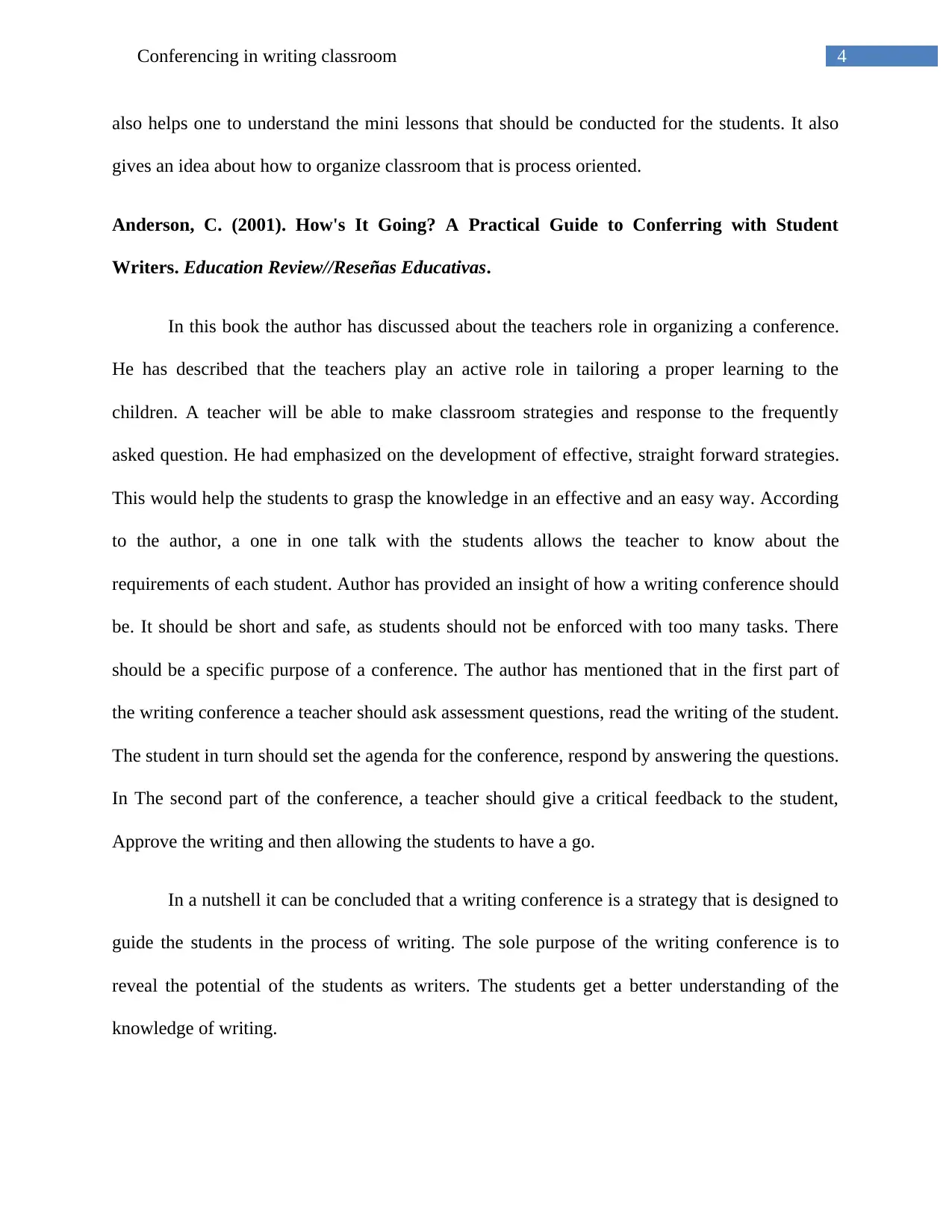
4Conferencing in writing classroom
also helps one to understand the mini lessons that should be conducted for the students. It also
gives an idea about how to organize classroom that is process oriented.
Anderson, C. (2001). How's It Going? A Practical Guide to Conferring with Student
Writers. Education Review//Reseñas Educativas.
In this book the author has discussed about the teachers role in organizing a conference.
He has described that the teachers play an active role in tailoring a proper learning to the
children. A teacher will be able to make classroom strategies and response to the frequently
asked question. He had emphasized on the development of effective, straight forward strategies.
This would help the students to grasp the knowledge in an effective and an easy way. According
to the author, a one in one talk with the students allows the teacher to know about the
requirements of each student. Author has provided an insight of how a writing conference should
be. It should be short and safe, as students should not be enforced with too many tasks. There
should be a specific purpose of a conference. The author has mentioned that in the first part of
the writing conference a teacher should ask assessment questions, read the writing of the student.
The student in turn should set the agenda for the conference, respond by answering the questions.
In The second part of the conference, a teacher should give a critical feedback to the student,
Approve the writing and then allowing the students to have a go.
In a nutshell it can be concluded that a writing conference is a strategy that is designed to
guide the students in the process of writing. The sole purpose of the writing conference is to
reveal the potential of the students as writers. The students get a better understanding of the
knowledge of writing.
also helps one to understand the mini lessons that should be conducted for the students. It also
gives an idea about how to organize classroom that is process oriented.
Anderson, C. (2001). How's It Going? A Practical Guide to Conferring with Student
Writers. Education Review//Reseñas Educativas.
In this book the author has discussed about the teachers role in organizing a conference.
He has described that the teachers play an active role in tailoring a proper learning to the
children. A teacher will be able to make classroom strategies and response to the frequently
asked question. He had emphasized on the development of effective, straight forward strategies.
This would help the students to grasp the knowledge in an effective and an easy way. According
to the author, a one in one talk with the students allows the teacher to know about the
requirements of each student. Author has provided an insight of how a writing conference should
be. It should be short and safe, as students should not be enforced with too many tasks. There
should be a specific purpose of a conference. The author has mentioned that in the first part of
the writing conference a teacher should ask assessment questions, read the writing of the student.
The student in turn should set the agenda for the conference, respond by answering the questions.
In The second part of the conference, a teacher should give a critical feedback to the student,
Approve the writing and then allowing the students to have a go.
In a nutshell it can be concluded that a writing conference is a strategy that is designed to
guide the students in the process of writing. The sole purpose of the writing conference is to
reveal the potential of the students as writers. The students get a better understanding of the
knowledge of writing.
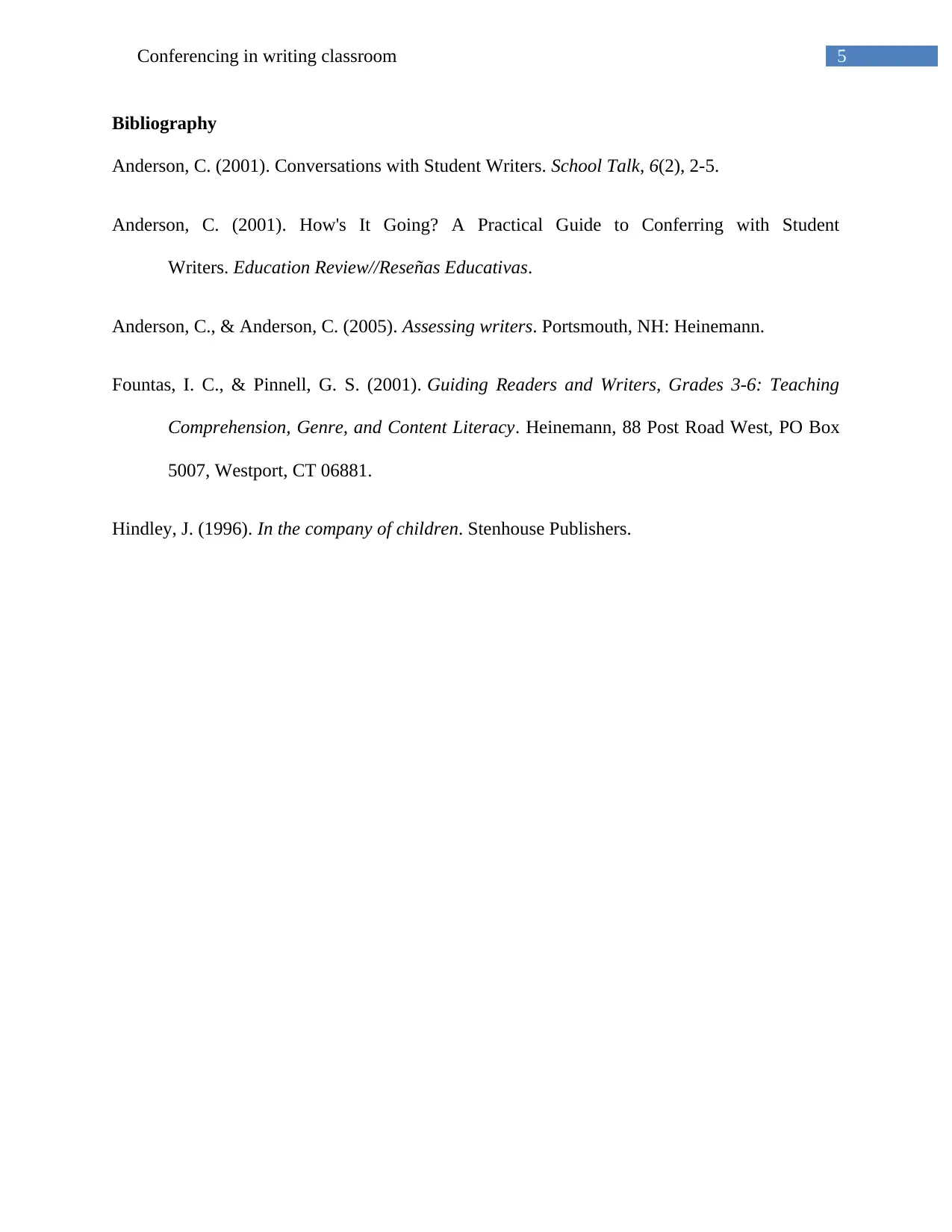
5Conferencing in writing classroom
Bibliography
Anderson, C. (2001). Conversations with Student Writers. School Talk, 6(2), 2-5.
Anderson, C. (2001). How's It Going? A Practical Guide to Conferring with Student
Writers. Education Review//Reseñas Educativas.
Anderson, C., & Anderson, C. (2005). Assessing writers. Portsmouth, NH: Heinemann.
Fountas, I. C., & Pinnell, G. S. (2001). Guiding Readers and Writers, Grades 3-6: Teaching
Comprehension, Genre, and Content Literacy. Heinemann, 88 Post Road West, PO Box
5007, Westport, CT 06881.
Hindley, J. (1996). In the company of children. Stenhouse Publishers.
Bibliography
Anderson, C. (2001). Conversations with Student Writers. School Talk, 6(2), 2-5.
Anderson, C. (2001). How's It Going? A Practical Guide to Conferring with Student
Writers. Education Review//Reseñas Educativas.
Anderson, C., & Anderson, C. (2005). Assessing writers. Portsmouth, NH: Heinemann.
Fountas, I. C., & Pinnell, G. S. (2001). Guiding Readers and Writers, Grades 3-6: Teaching
Comprehension, Genre, and Content Literacy. Heinemann, 88 Post Road West, PO Box
5007, Westport, CT 06881.
Hindley, J. (1996). In the company of children. Stenhouse Publishers.
⊘ This is a preview!⊘
Do you want full access?
Subscribe today to unlock all pages.

Trusted by 1+ million students worldwide
1 out of 6
Related Documents
Your All-in-One AI-Powered Toolkit for Academic Success.
+13062052269
info@desklib.com
Available 24*7 on WhatsApp / Email
![[object Object]](/_next/static/media/star-bottom.7253800d.svg)
Unlock your academic potential
Copyright © 2020–2025 A2Z Services. All Rights Reserved. Developed and managed by ZUCOL.




